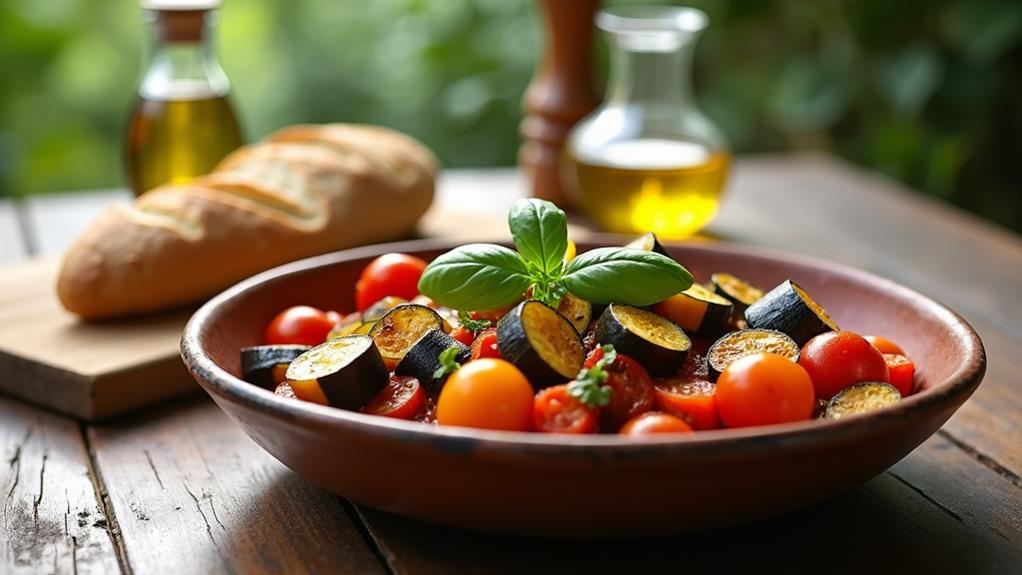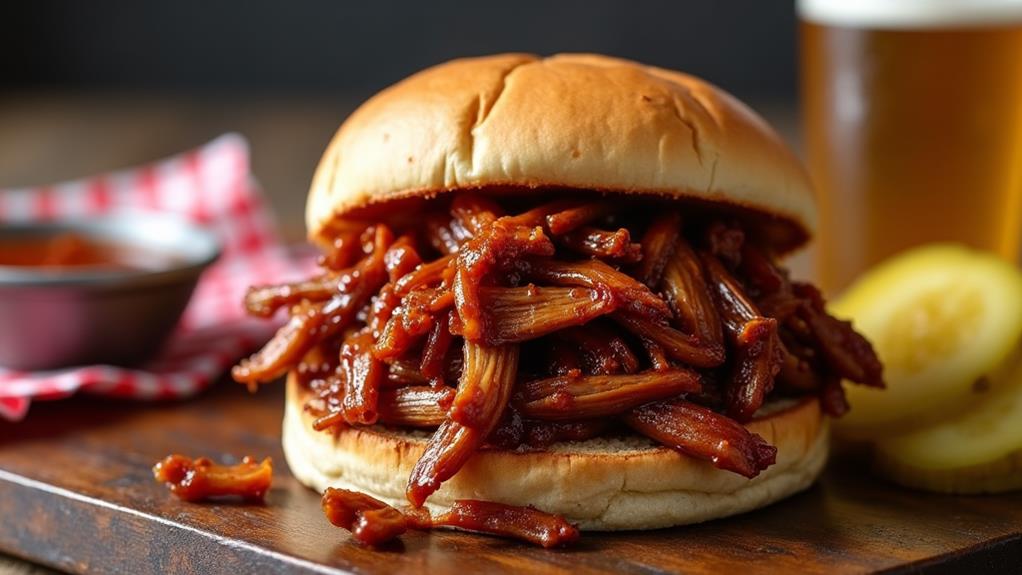Did you know that ratatouille, a dish that's now beloved worldwide, originated from humble beginnings as a poor man's meal in 18th-century Nice? You'll find this colorful medley of summer vegetables has come a long way since then, gracing tables from casual family dinners to upscale restaurants. As you explore the rich history and vibrant flavors of this Mediterranean classic, you'll discover why it's become a staple for home cooks and professional chefs alike. The secret to its enduring popularity lies not just in its simplicity, but in the way it celebrates each ingredient's unique character.
Key Takeaways
- Ratatouille is a classic French dish featuring summer vegetables like eggplant, zucchini, tomatoes, and onions.
- The dish originated in Nice, France as a peasant meal and has evolved into a refined staple of French cuisine.
- Cooking involves sautéing vegetables separately or together, then simmering to create a harmonious blend of flavors.
- Ratatouille can be served hot, at room temperature, or cold as a side dish, main course, or topping for bread.
- The dish's flavor improves over time, making it ideal for preparing in advance and enjoying as leftovers.
History
While the exact origins of ratatouille are debated, it's believed to have emerged in the 18th century in Nice, France. This humble dish began as a simple peasant meal, utilizing the abundance of fresh vegetables available in the region.
Originally, each vegetable was cooked separately and then combined, a method that's still practiced by some traditionalists today.
As you explore the history of ratatouille, you'll find that it gained popularity throughout Provence and eventually spread across France. The name "ratatouille" comes from the Occitan word "ratatolha," which means "to stir up." This reflects the rustic nature of the dish and its preparation method.
Over time, ratatouille evolved from a basic vegetable stew to a more refined dish, with chefs experimenting with different cooking techniques and presentations.
In the 20th century, it became a staple of French cuisine, celebrated for its versatility and ability to showcase the flavors of summer produce.
Today, you'll find variations of ratatouille throughout the Mediterranean region, each with its own unique twist on this classic vegetable medley.
Recipe
Summer Vegetable Ratatouille is a vibrant and flavorful dish that showcases the best of summer produce. This simplified version uses just five key ingredients to create a delicious and satisfying meal that captures the essence of Provençal cuisine.
By focusing on eggplant, zucchini, tomatoes, onions, and olive oil, this recipe creates a harmonious blend of Mediterranean flavors that perfectly encapsulates the taste of summer. The result is a versatile dish that can be enjoyed hot, at room temperature, or cold, making it ideal for various meals and occasions.
- 1 large eggplant (about 1 pound or 450g), cubed
- 2 medium zucchini (about 1 pound or 450g total), sliced
- 1 large onion, chopped
- 4 medium tomatoes (about 1 pound or 450g), diced
- 1/4 cup (60ml) olive oil
- Salt and pepper to taste
Heat the olive oil in a large skillet or Dutch oven over medium heat. Add the chopped onion and cook until softened, about 5 minutes. Add the cubed eggplant and sliced zucchini, stirring to coat with oil. Cook for about 10 minutes, stirring occasionally, until the vegetables begin to soften.
Add the diced tomatoes and continue cooking for another 15-20 minutes, or until all vegetables are tender and the mixture has thickened. Season with salt and pepper to taste. Remove from heat and let cool slightly before serving.
For the best flavor, use fresh, ripe summer vegetables at the peak of their season. Allow the ratatouille to cool for a few minutes before serving, as this will help the flavors meld together.
If you have leftovers, store them in an airtight container in the refrigerator for up to 3 days. Many find that the flavors improve after a day or two, making this dish an excellent option for meal prep or make-ahead dinners.
Cooking Steps
To create your Summer Vegetable Ratatouille, you'll follow a series of simple cooking steps that bring out the best flavors of your fresh ingredients.
Begin by heating olive oil in a large skillet or Dutch oven, then add your chopped onions and cook until they're softened and translucent.
Next, you'll incorporate the cubed eggplant and sliced zucchini, allowing them to cook for about 10 minutes before introducing the diced tomatoes, which will simmer together with the other vegetables until everything is tender and the mixture has thickened to perfection.
Step 1. Heat Oil, Soften Onions
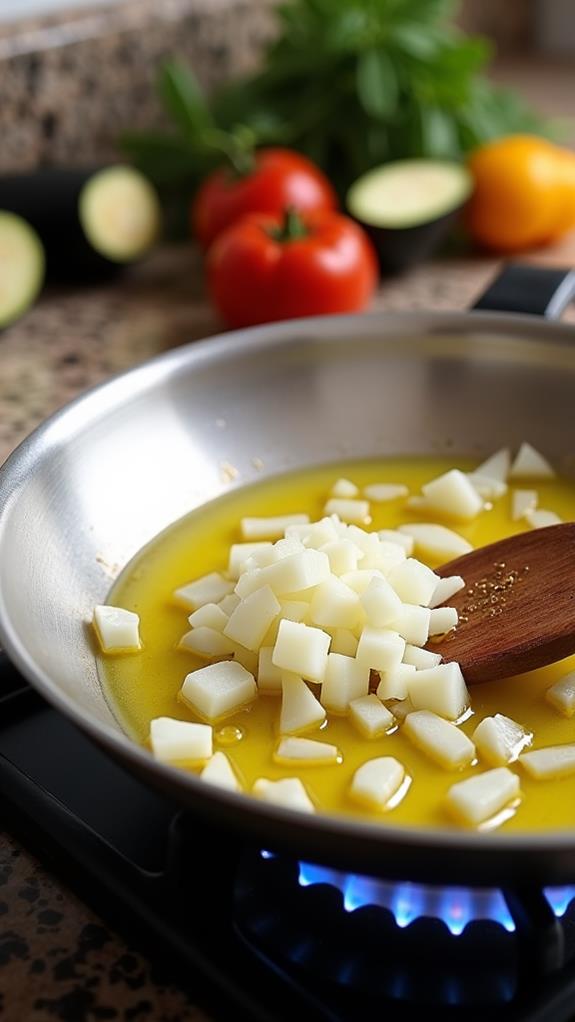
Begin by heating a large skillet or Dutch oven over medium heat.
Once the pan is hot, pour in 1/4 cup of olive oil, allowing it to warm and shimmer across the surface. This step is crucial for creating a flavorful base for your ratatouille.
Next, add the chopped onion to the heated oil. You'll want to use a large onion, diced into uniform pieces about 1/4 inch in size.
Stir the onions gently with a wooden spoon, coating them evenly with the olive oil. As they cook, you'll notice them becoming translucent and softening. This process usually takes about 5-7 minutes.
Don't rush this step; allowing the onions to cook slowly will develop a sweet, caramelized flavor that'll enhance your entire dish. If you notice the onions browning too quickly, reduce the heat slightly.
You're aiming for soft, golden onions that'll provide an aromatic foundation for the other vegetables. Once they're tender and fragrant, you're ready to move on to the next step in creating your delicious summer ratatouille.
Step 2. Add Eggplant and Zucchini
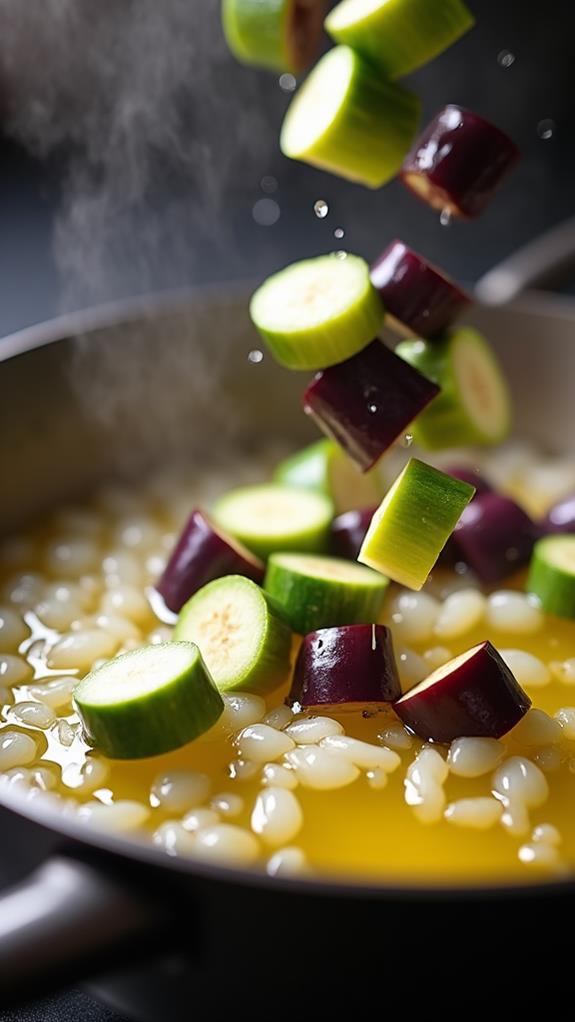
Once the onions have softened, it's time to add the eggplant and zucchini to the pan. Carefully place the cubed eggplant and sliced zucchini into the skillet, distributing them evenly among the softened onions. These two vegetables form the heart of your ratatouille, providing a delightful contrast in textures and flavors.
As you cook, gently stir the vegetables to ensure they're coated with oil and cooking evenly. You'll want to maintain medium heat, allowing the eggplant and zucchini to slowly release their moisture and begin to soften.
This process usually takes about 10 minutes, during which you should stir occasionally to prevent sticking and promote even cooking. You'll notice the vegetables start to shrink slightly and take on a golden hue.
Don't worry if they're not fully cooked at this stage; they'll continue to soften when you add the tomatoes later. The key is to achieve a tender-crisp texture that'll hold up well in the finished dish. If you find the vegetables are sticking, you can add a small amount of additional olive oil as needed.
Step 3. Add Tomatoes, Simmer
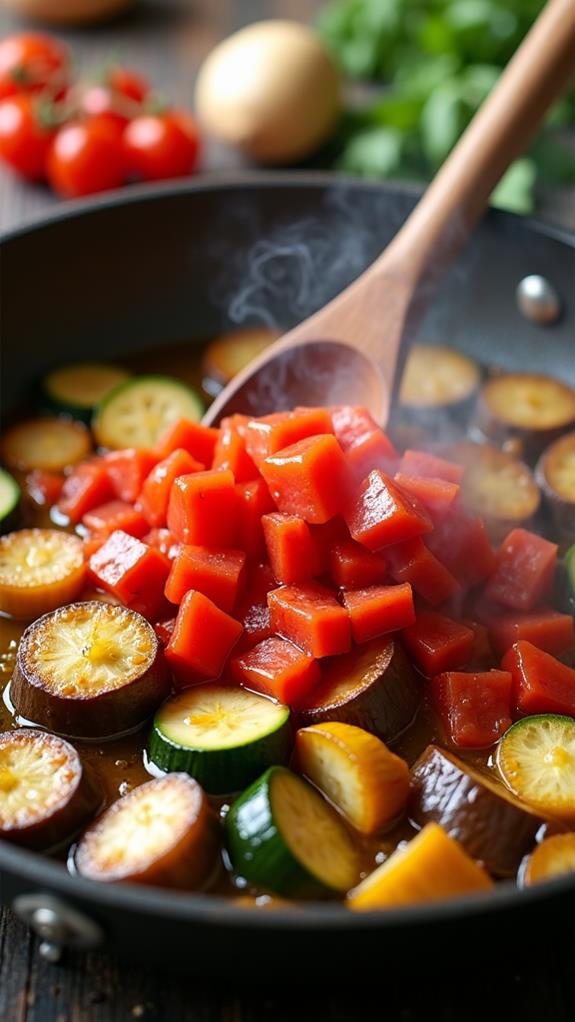
After the eggplant and zucchini have cooked for about 10 minutes, it's time to add the diced tomatoes to your ratatouille. Gently pour the tomatoes into the skillet, distributing them evenly among the other vegetables.
As you stir, you'll notice the tomatoes releasing their juices, which will help create a rich, flavorful sauce.
Reduce the heat to medium-low and let the mixture simmer. This slow cooking process allows the flavors to meld together and the vegetables to become tender.
Stir occasionally to prevent sticking and ensure even cooking. You'll want to simmer the ratatouille for about 15-20 minutes, or until all the vegetables are soft and the sauce has thickened slightly.
During this time, you'll notice the aroma of the dish becoming more pronounced, filling your kitchen with the scent of summer.
As the ratatouille simmers, taste it and adjust the seasoning with salt and pepper as needed.
Remember, the flavors will continue to develop as the dish cools, so don't be tempted to over-season.
Once the vegetables are tender and the sauce has reached your desired consistency, remove the skillet from the heat.
Step 4. Season With Herbs and Spices
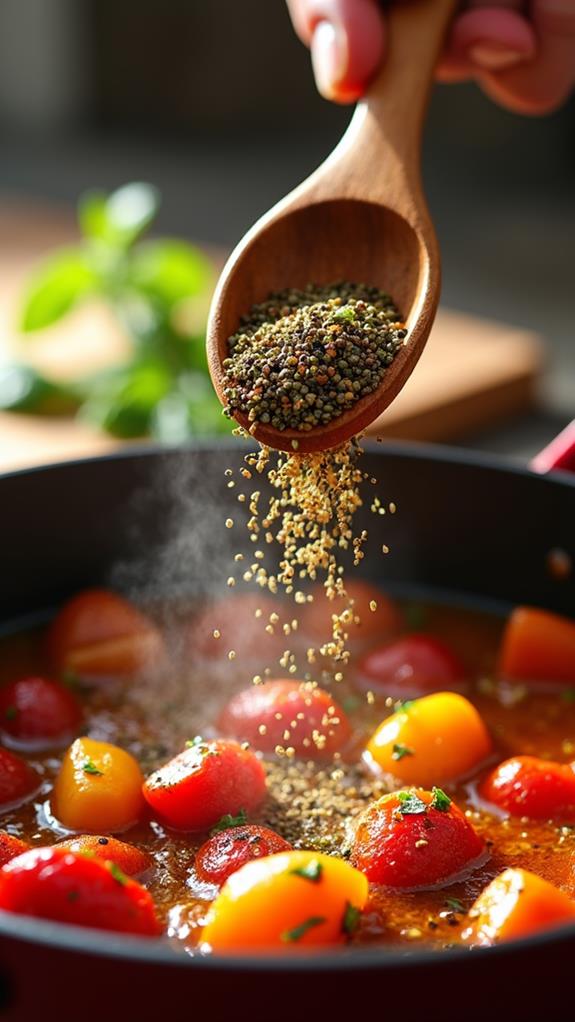
The final step in perfecting your ratatouille is to season it with herbs and spices. This crucial stage elevates the dish from a simple vegetable medley to a flavorful, aromatic masterpiece. You'll want to add a combination of fresh and dried herbs that complement the sweetness of the vegetables and enhance their natural flavors.
Start by incorporating fresh basil, which adds a bright, peppery note to the dish. Tear a handful of leaves and gently stir them into the simmering vegetables.
Next, add a pinch of dried thyme and oregano, both of which contribute earthy, slightly minty flavors that pair well with the tomatoes and eggplant. Don't forget to season with salt and freshly ground black pepper to taste, adjusting the amounts as needed.
For a touch of Provençal authenticity, you can also include a bay leaf or two during cooking, removing them before serving.
Step 5. Let Cool Before Serving
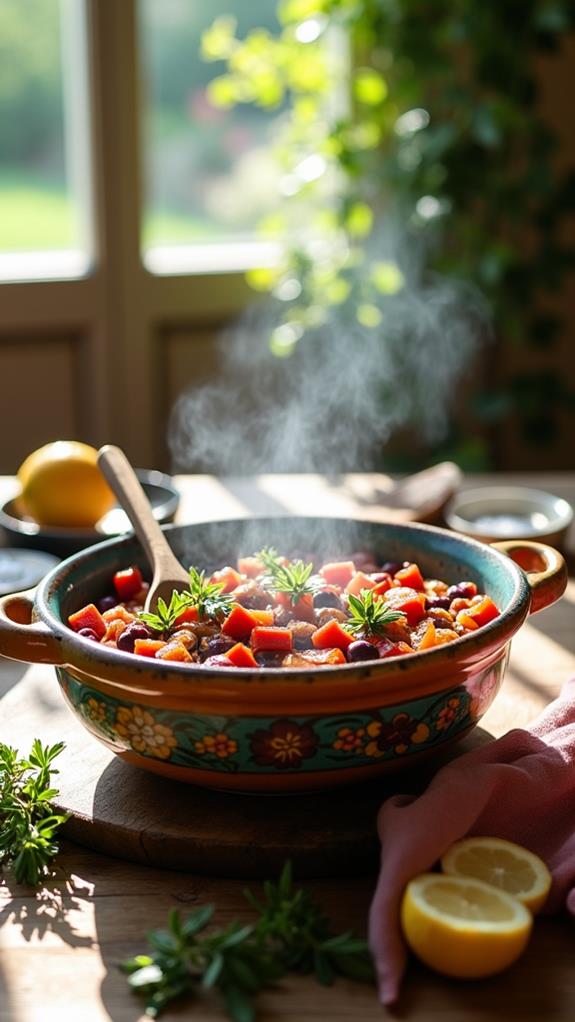
Now that you've perfectly seasoned your ratatouille, it's time to let it cool before serving. This crucial step allows the flavors to meld and intensify, creating a more harmonious and delicious dish.
Remove the pot from the heat and set it aside, uncovered, for about 15-20 minutes. During this time, the vegetables will continue to release their juices and absorb the seasoning, resulting in a richer taste profile.
As the ratatouille cools, you'll notice the aroma filling your kitchen, hinting at the delightful meal to come. Resist the temptation to serve it immediately; patience will reward you with a more flavorful experience.
Once it's cooled slightly, give the ratatouille a gentle stir to redistribute the vegetables and juices. This will ensure that each serving has a perfect balance of ingredients.
You can now serve your ratatouille warm, at room temperature, or even chilled, depending on your preference. Remember, ratatouille often tastes even better the next day, so don't hesitate to make extra for leftovers.
Store any remaining portions in an airtight container in the refrigerator for up to three days.
Final Thoughts
Three key points make this simplified Summer Vegetable Ratatouille a standout dish. First, its focus on essential ingredients captures the essence of traditional ratatouille while streamlining the cooking process.
You'll appreciate how the five main components work together to create a harmonious blend of flavors and textures.
Second, the versatility of this dish allows you to enjoy it hot, at room temperature, or cold, making it suitable for various meals and occasions. You can serve it as a side dish, main course, or even as a topping for grilled bread.
Lastly, the ratatouille's ability to improve with time means you'll have delicious leftovers for days. As the flavors continue to meld in the refrigerator, you'll find that each serving becomes more flavorful and satisfying.
Remember to use fresh, seasonal produce for the best results, and don't be afraid to experiment with additional herbs or spices to suit your taste preferences.
This simplified ratatouille recipe proves that sometimes, less truly is more when it comes to showcasing the natural flavors of summer vegetables.

